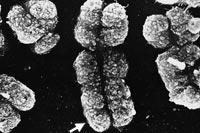Autism and fragile X syndrome

In the 1980s, a Leioa research group worked with dermatoglyphs, that is, with hand and foot marks. These morphological markers are very appropriate for the study of body asymmetry, which were the ones that made autistic children.
The results of these studies showed that autistic boys and girls had a greater tendency to variable asymmetry with respect to the rest of people, that is, to an asymmetry without model.
Weaknesses
After morphological studies, cytogenetic studies were conducted with these children. To do this, the chromosomes of the children were analyzed considering that on the chromosomes there were points that tended to break. One of these points is found on the X chromosome and is known as FRAXA.
In view of the results, the researchers concluded that autistic children had a higher than normal tendency to express fragile places. In addition, FRAXA expressed itself only in autistic children, but not in all. At that time it was the only way to identify the syndrome.
Too many repetitions
However, in the early 1990s the FMR1 gene was identified in FRAXA. This gene is responsible for fragile X syndrome. Bear in mind that one of the most important features of fragile X is autistic behavior.
Thereafter, the research team began to study this gene. In order to verify the degree of rooting of fragile X in the Basque Country, molecular studies were conducted with children with intellectual disabilities.
Once blood DNA is obtained, the diagnosis is simple. The FMR1 gene contains a trinucleotide CGG (cytosine guanine guanine). This trinucleotide is
repeated 6 to 54 times in healthy people, but some have between
54 and 200 repetitions that are premuted. Finally, those with a fragile X mutation have from 200 repetitions to over 1,000.
The results were surprising: None of the children with fragile X mutation were of Basque origin. This motivated the group to investigate the stability of the FMR1 gene in Basque society, and found that the frequency of unstable variants of
this gene was lower than that of other societies of Caucasian origin.
At this conclusion, researchers are now working with premutated people, as this number of GCC repeats have recently been associated with three pathologies. On that road there is still much to investigate about the fragile X.
Buletina
Bidali zure helbide elektronikoa eta jaso asteroko buletina zure sarrera-ontzian











